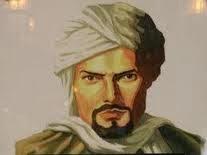
By the eve of the third millennium and precisely in 2003, the whole Islamic and Arab world celebrated with pride the 700 anniversary of the Tangerine voyager Ibn Battûta (A.D. 1304-1377). Without doubt, this great figure who rivalled Marco Paulo is among the incomparable galactic travellers of the world. Ibn Battûta deserved this cosmopolitan fame because of his splendid achievements, like journeys to the Islamic countries and the Near East: Egypt, Sardinia, Palestine, Syria, Iraq, Arabia, Oman, Yemen, Iran, Smaller Asia, Uzbekistan, Ethiopia, Somalia, Kenya, Tanzania, Afghanistan, India, China, Maldives, Vietnam, Indonesia, Ceylon, among others. His real name was Chams Eddin Ibn Abdellah Allawati Attanji. Having finished his religious studies in the theological institute, he left his native city Tangier at the 22 years (A.D. 1325) for Mecca in fulfilment of a religious ideal: the pilgrimage. Ibn Battûta did not return to his native land till A.D. 1349, a few months after the death of his mother. He spent some years there, until the King of Fez ordered him to undertake the job of peripatetic ambassador. Ibn Battûta was again inspired to discover new horizons, opening up other notable routes to Andalusia and to the sub-Saharan region of Mali and Niger. Peculiarly, this nomadic hero did not settle down until A.D. 1353 in Fez, again after his appointment as a secretary in the royal cabinet by the Merinid sovereign, Abú Inan.
In his fabulous voyage, Ibn Battûta travelled about 120,000 km. He visited pagan nations along with monotheist states, traversing the limits of the Islamic world. Thus he crossed the continents of Africa, Asia and Europe, in an epoch in which most countries had a high rate of insecurity in their ways, not counting the great difficulties of travel. Ibn Battûta also endured the rigors of the climate and he was saved several times from epidemics. In many cities that he visited, this Saracen met the generous hospitality, as well as the poverty of his guests. Sometimes he lived in palaces; other times in huts. In China he had a cultural and religious shock, seeing the Chinese devouring with joy dogs and cats! But…if he had not supported all these conditions, this hero never would have achieved such success. During his sojourn in Mecca, Ibn Battûta studied jurisprudence, which soon allowed him to practice as a judge in countries like the Maldives. On the other hand, his knowledge of Persian and Turkish enabled him to gain quickly the confidence and the admiration of his interlocutors. This was so for Persian and Turkish were among the major languages in the non-Arab states of the Muslim World. Ibn Battûta was able to visit kings and dignitaries of the great empires of his era. His personal magnetism charmed his hosts. In the gardens of palaces and mansions, this indefatigable Saracen assiduously discoursed with his hosts about poetry, theology, geography, crusades and so on.
As a testimony of his trips, and with the aid of Ibn Jouzay (secretary of the Merinid Sultan Abú Inan), Ibn Battûta left a great publication to humanity: the Rihla. In addition to his notes written in classical Arabic during his trip, Ibn Battûta dictated his narrations in Moroccan Arabic to his comrade at the royal palace. Thus, this esoteric master reworked the text in the usual language of scholars. The Rihla is a travel chronicle and one of the most translated works in the world, even in languages of countries where Ibn Battûta did not set foot. The Rihla is an exciting compendium, or rather, a mixture of genres and disciplines. It is, simultaneously, autobiography, novel, history, geography, toponymy, policy, hagiography, liturgy, numismatics, ethnography, anthropology and so forth. As an example of these translations, one can cite one in Spanish by Serafín Fanjul and Federico Arbos, titled Ibn Battûta: A través del Islam and another one by the famous British historian and orientalist H.A.R. Gibb entitled The travels of Ibn Battuta, A.D. 1325-1354.
According to the Moroccan scholar Dr. Abdelhadi Tazi, the mortal remains of this illustrious ambassador of Islam rest peacefully inside Anfa cemetery (a district in Casablanca) with no tablet commemorating his voyage achievements. It was precisely in that part of Casablanca where Ibn Battûta was exercising as a judge and where he and the rest of local population caught bubonic plague. But fortunately, nowadays in the labyrinths of the old medina of Tangier stands a tiny mausoleum that pertains to Ibn Battûta’s family and that contains a memorial plaque in his honour. Since this mausoleum is part of the six tourism itineraries of the famous Tangier’s medina, then every day this place becomes a visiting space of numerous intellectuals and tourists!



![Morocco Suffers Defeat Against South Africa in African Nations Cup Qualifier [Highlights Included] Achraf Hakimi](https://themoroccantimes.com/wp-content/uploads/2023/04/achraf-hakimi-238x178.png)
